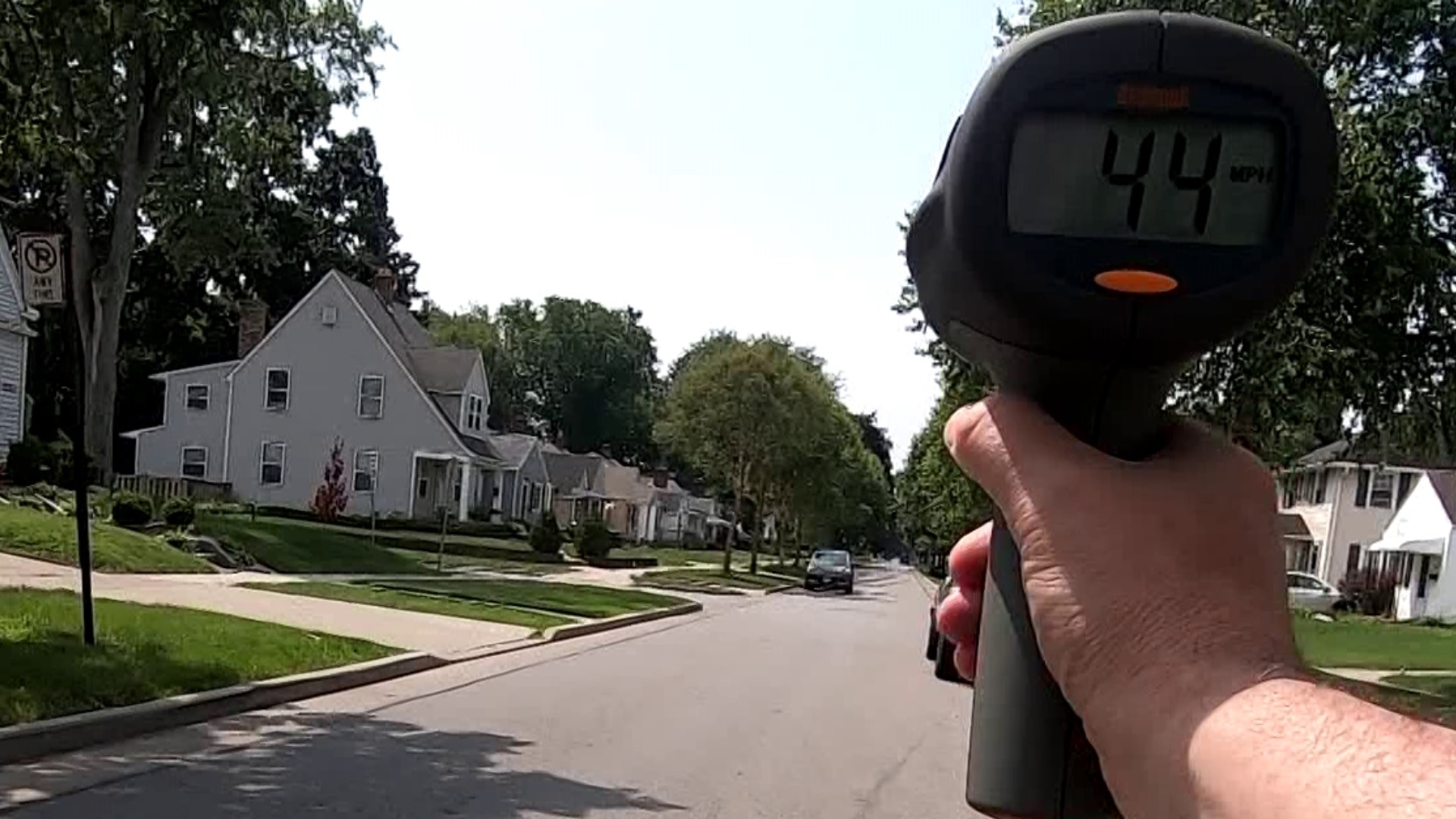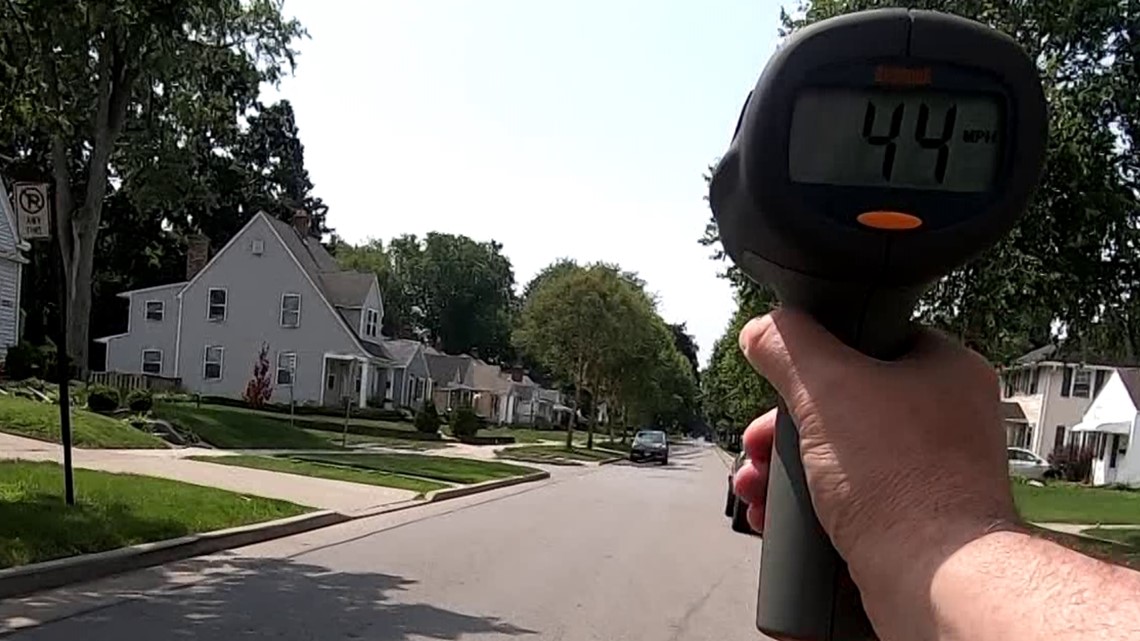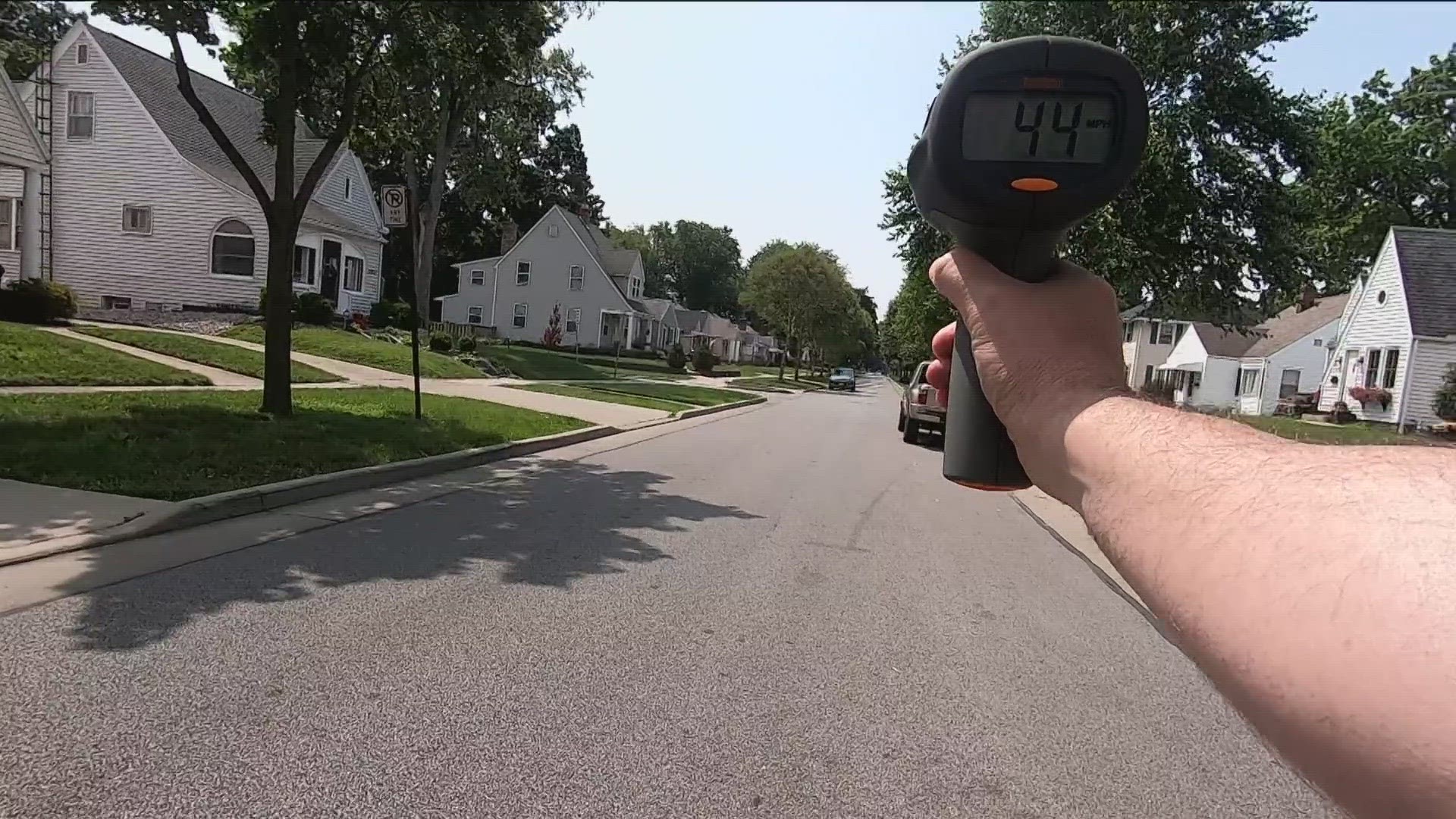Fast track to frustration: Speeders anger residents; Toledo misses out on thousands in ticket revenue | 11 Investigates
Public records show the Toledo Police Department classifying citations under Ohio Revised Code, sending more than $150,000 to county coffers and not the city.

For years, Stephanie Hinamon has seen drivers racing down Sherbrooke Road.
Besides living in fear of a child chasing a ball across the street in front of a driver ignoring the 25 mph speed limit, Hinamon has witnessed destruction from reckless drivers.
“We’ve had my daughter’s car totaled, and we’ve had the city remove a tree because it’s been hit so many times from speeding,” she said, pointing to a nearby bare spot.
No need for speed Drivers clocked at nearly double the speed limit
During recent phone banks, members of the 11 Investigates team have heard from multiple residents concerned by speeding drivers in their neighborhoods.
WTOL 11 purchased a speed gun to see for ourselves how prevalent the problem is; we discovered speeding is very common, particularly in west Toledo.
On several afternoons, we clocked drivers traveling down Sherbrooke Road and Kenwood Boulevard at speeds far over the speed limit.
During our time on Sherbrooke Road, the majority of drivers exceeded the 25 mph limit. At one point, a sport utility vehicle owned by the city of Toledo raced past at 44 miles per hour.


In August 2020, city council attempted to address the issue by doubling fines for tickets received while speeding in residential areas. Money from those fines is set aside in a separate fund, meant to purchase additional traffic enforcement equipment.
Changing the municipal code Is the legislation effective?
In an attempt to determine how effective the legislation has been in deterring residential speeding, 11 Investigates requested all speeding citations written by Toledo police.
The section of the Toledo Municipal Code tweaked by the legislation is 333.03B3, which involves speeding in portions of the municipality with speed limits of 25 mph.
Records show that six citations were written under this section in 2020, but just one in the two and half years since. Since the beginning of 2021, $70 in fines have been collected under 333.03B3.
“When we pass legislation that doubles fines, the point is to make it more of a penalty for people, hopefully, to then change driving habits and make our neighborhoods safer. If they’re not getting the fine, it’s not going to change behavior,” Toledo City Council Member Sam Melden said.
He added that he had recently talked to the police department about citing under the city's code.
What the statistics say A traffic enforcement ridealong
11 Investigates showed the data to the Toledo Police Department, which agreed to discuss the issue and also agreed to allow a WTOL 11 photographer to go on a traffic enforcement ride-along for an entire morning.
“I didn’t recall that legislation being passed in 2020. It slipped my mind. I worked midnights at that time,” Toledo Police Sgt. Aaron Riter said. “I didn’t recall it, so I wasn’t using it, and I should have been, and I will be going forward, as will the rest of the traffic section.”
Very few speeding citations have been written under any section of the TMC. Last year, there were only two – for the entire year – under all sections of the Toledo Municipal Code.
11 Investigates found, however, that 721 speeding citations were issued under 4511.21C of the Ohio Revised Code in the first seven months of 2023. The section is a catch-all of several types of speeding violations – in school zones, on highways, in residential areas, on state routes within the city.
Though several residents told us they see little enforcement in neighborhoods, it’s impossible to tell the number of tickets that have been handed out in these areas because they aren’t being classified under specific sections, just the generic section of the ORC.
“I wasn’t aware completely that things were broken down statistically like that, that you could look at it and say, 'well, this "x" number of tickets were written in residential zones, "x" number of tickets were written in school zones, "x" number were written in 35-mph zones,'" Riter said. "I have now been educated on that."
Cracking the code Missing out on money
However, a more concerning problem is that nearly all speeding tickets are being written under the ORC, meaning that 100% of that revenue is distributed to the county, not the city of Toledo. The city has missed out on collecting tens of thousands of dollars in the records we saw since 2020.
Through the beginning of July, $35,138 was collected from ORC fines and $0 from TMC in 2023.
In 2022, $64,459 in fines were collected from ORC citations and $70 from TMC tickets.
In 2021, the numbers were $31,600 from ORC fines and $0 under the TMC.
In 2020, it was $20,360 that went to the county and $325 for the city.
Since Jan. 1, 2020, and through July 5 of this year, $151,557 has gone to the county and only $395 to the city.
When 11 Investigates looked at Akron and Cleveland, the numbers were reversed.
Akron police wrote a similar amount of speeding tickets in 2022. There were 1,204 tickets in Akron versus 1,398 in Toledo. However, 1,194 tickets were written under the Akron Municipal Code, while Toledo only had two under the TMC.
In Cleveland last year, 3,575 speeding tickets were written, and only 19 were written under the Ohio Revised Code. Cleveland kept 100% of the revenue from 3,556 tickets.
After interviewing with us and looking at the data, Riter said he and the rest of traffic enforcement would now be writing citations under applicable TMC sections. In August, there were seven citations filed under TMC 333.03B4.
Overall, speeding citations are up sharply this year, on track to meet the department’s goal of a 20% increase.
“I think if you look back prior to 2020, there’s a pretty decent increase in the number of speeding tickets written, and we’re doing the same thing this year,” he said. “It’s having an effect in certain places.”
Dangerous driving A troubling trend
According to Riter, the goal isn’t to ruin a driver’s day. The goal is to cut down on crashes.
Early Tuesday morning, speed was blamed for a fatality on Reynolds Road in south Toledo.
RELATED: TPD: Man ejected, killed after crashing speeding car into utility pole in south Toledo early Tuesday
“We definitely care," Riter said. "Our interest is definitely to reduce not just serious injury and fatal accidents, but to reduce accidents in general, as speed is a contributing factor to a great number of accidents that occur within our city."
It is also a goal of Melden and the rest of Toledo City Council.
More than once during a 30-minute interview with 11 Investigates, Melden said he is partnering with police on traffic safety, saying better equipment is needed for police. He added that structural changes to some roadways can also help slow the speeds.
Taking action Toledo City Council making changes
During Tuesday's city council meeting, members unanimously passed a resolution to reduce the speed limit on Kenwood Boulevard to 25 miles per hour. The area was the site of a fatal vehicle-pedestrian accident in June and is often cited by residents as a neighborhood with speeding issues.
“It is frustrating that people are speeding on residential streets," Melden said. "It’s frustrating that people don’t drive through neighborhoods and pretend it’s their neighborhood, pretend that it’s their kid playing on that front yard."
Hinamon said she welcomes more attention on the issue.
“You try to sleep with your windows open and it’s so hard. It’ll be two or three in the morning and motorcycles will go by at 100 miles per hour or cars are going super fast. Just trying to leave your driveway in the morning or five o’clock when everyone’s coming home,” she said, stopping to point out a car racing by. “Here comes one now. Speed is such a huge concern.”

